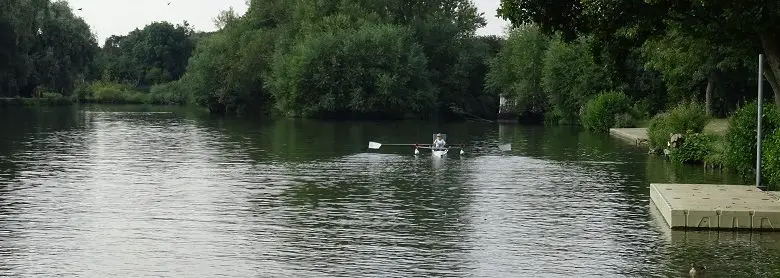
Disability and sport: have you considered adaptive rowing?
On moving to Oxford for my first graduate job, where I couldn’t afford a private pool membership (I have an unstable spine, so prefer to swim in places where I am less likely to be jumped on!) and where there is a distinct lack of open water, I had to have a rethink about how to maintain my fitness. I’m 3′ tall, walking is a challenge and I’m hard of hearing – if I’m in a big group, it helps to have someone keeping an eye on me. I also don’t ‘fit’ standard exercising aids.
So still full of that Paralympic spirit that the London 2012 Games had inspired in all of us, I googled adaptive water sports in Oxford, and rowing topped the list. Even better, a club was only 10 minutes from my new flat! Being a brazen Scot I marched down in my wheelchair to the City of Oxford Rowing Club and asked (demanded) to have a go.
As a shortie, I was at a bit of a disadvantage with the length between the footplate (where you place your feet to push against as your row) and the sliding seat. But the coaches were not going to let that be an issue, particularly our head coach, who never fails to think outside of the box. I now row using a fixed seat and two blocks of wood added to the footplate so I can reach it.
The next thing I knew I was on the squad rota and a t-shirt had been ordered for me (although this had to also be shortened as well because even a ‘small’ was to too big for me!) The adaptions mean I scull rather than row – sculling essentially means I use two oars, as opposed to one, which is what you do in rowing. I also use two shortened oars (called blades).
In the winter, when it’s too chilly for outside rowing, I am able to use a conventional rowing machine with no adaptations, which allows my legs to get some exercise! I have taken part in the Indoor National Championships as part of an adaptive rowing team. My personal best is 500 meters in around 4 and a half minutes. On water I can do 400 metres in 3 minutes 39.
In 2013, I was having physiotherapy treatment for Repetitive Strain Injury, but sculling has replaced that therapy and it has mostly cured the constant aches I was getting. I attribute it also to my improved lung function. These physical improvements contribute to my mental wellbeing – my happy place is definitely the river nowadays and nothing beats sculling down the Thames waterways and viewing the famous Oxford skyline.
I am in debt to the many volunteers that City of Oxford Rowing Club have, who give up their Sunday mornings to support me and others in our exercise. I have just progressed to using a single scull, after 3 years of using a double with an abled volunteer sculling with me and another person ‘bankriding’ (which means someone who walks on the bank alongside) to monitor my skills (or lack of them!) Depending on ability, each sculler uses at least two volunteers, to help with loading and rigging up. Without them, there would not be an adaptive squad.
For more information on how to get involved in rowing, visit the British Rowing website and its page on adaptive rowing.
By Jo Barber
Photo credits: Phil Barber
Check out…
- Top 10 Paralympians who inspire us ahead of Rio 2016
- Wheely Boat Trust: making boats accessible
- Table tennis Paralympian Will Bayley in the spotlight
Will you be watching the Paralympics? We certainly will, so follow us @DHorizons and on Facebook using the hashtags #Rio2016 and #Paralympics.

